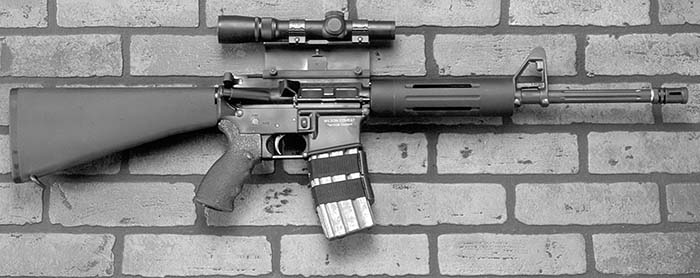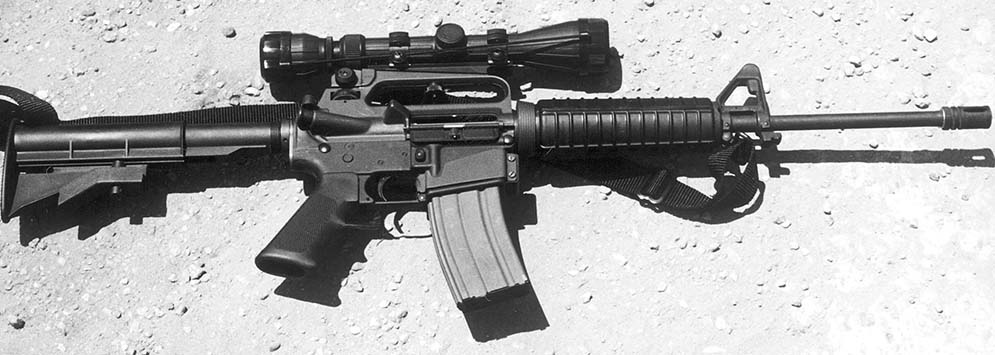A close civilian approximation of the M4, with a mounted telescopic sight.
By Bob Campbell
Within the framework of the AR 15/M 16 rifle there are subtypes that are very interesting, perhaps even more useful than the original gun. One of the most popular, a weapon of almost legendary reputation, is the CAR 15/M 177 or M4 Carbine. The first short barrel short stock M 16 variants appeared in the late 1960’s. They met with varying degrees of success. I’ve fired most, a notable exception to my experience being the ‘port firing’ M 16’s designed for use within armored vehicles. Early guns in the CAR 15 series were sometimes called Commandos. The original guns coupled a ten inch barrel with a folding or collapsing stock. Colt had wished this line to be known as the CAR 15 line to signify the difference between Colt and Armalite production.
The short XM 177 received and kept the CAR 15 tag. These guns were criticized on several points, especially reliability. Col. Tony Herbert, the most decorated enlisted man of the Korean conflict served as a officer in Vietnam. He found the M 16 was a fine rifle, well suited to the conflict, but derided the CAR 15 as unreliable. He felt it had more show than performance, likening its image to that of the Thompson submachinegun of another war. The XM 177E2, with a longer 11.5 inch barrel and other types of ‘tweaking’, proved more reliable.
The XM 177E2 was dropped from production. The early short M 16’s were plagued with reliability and ammunition performance problems.
Later carbines were developed which featured 14.5 inch long barrels. These longer barrels work much better with the M 16 gas system and retain more of the 5.56mm cartridge’s effectiveness. This is a round that relies upon high velocity for effectiveness. Wound ballistics are compromised when the velocity falls below 2,500 fps. With enhanced ammunition performance and increased reliability, later variants such as the 1980’s M 16A2 carbine were much more effective weapons. Many in the Army wished to adopt the Carbine as a standard weapon but it remained for the most part a special team weapon, often issued to drivers and dog handlers or other needing a short light weapon. It is much more effective than any handgun or submachinegun, weapons often assigned this task.

The M4 and M4A1 are recent variants, being adopted in 1994. Both are in wide use by all of the services. Two models are in use. The M4 has the familiar ratchet-type three shot burst limiter. When the weapon is on full auto, it can be fired only in a three shot burst mode. At least in my hands, the usual result is two shots close together and one with greater dispersion. The M4A1 has the more conventional mode of fire.
A trained operator can tickle the trigger well enough to fire two to four round bursts in full auto mode. The trick is in training, a greater indicator of success in the field than gear. The M4’s currently in service are flat-top models, or M 16 variants with removable carrying handles. These weapons may easily be fitted with telescopic sights.
The M4 type weapon is also popular with civil agencies, especially Special Weapons and Tactics units. The needs of mobile SWAT teams are well served by the M4. The M4’s 14.5 inch barrel is not civilian legal, but a number of approximations are available with legal length 16 inch barrels. They mimic the M4 in a reasonable manner, of course without the full auto option. I’ve fired quite a few and they are accurate, reasonably compact weapons. Several versions are offered by Wilson Combat. Not as well known for his rifles, Wilson’s rifles and carbines are world class weapons.
The true M4 exhibits the following features—
- 14.5 inch, 1 in 7 inch twist barrel
- 7 3/4 inch round handguard
- Double heat shield
- Flat top receiver
- Four position buttstock—Closed/Full open/one half and three quarters open.
Early ammunition problems with the CAR 15 type guns are well documented. Often, downsizing a weapon does not work as well as the designer had hoped. M4’s currently in use feature an increased diameter gas port, which aids in overall function.
The M4 carbine has been well received in service, passing stringent testing. It is used by airborne units, SEALs, and other special operators.
Notably, the availability of the M4 carbine has resulted in less utilization of other weapons such as the Heckler and Koch MP5 and other weapons. The M4 can perform the same tasks but arguably much better, while fulfilling the mission envelope of the M16A2 as well.
The carbines are six inches shorter than the M16A2, a significant advantage when parachuting or traveling in a raft, and an advantage in house clearing as well.
The problems encountered by Israeli and Palestinian forces in house clearing with the M16 and Galil are well known. The UZI found favor with the Israelis. They would not allow Palestinian forces to use the UZI. The UZI is a good weapon of the type, but not comparable to the M4.
The question of accuracy and lethality remains with the M4. Accuracy to even 500 yards is comparable to but not equal to the M16A2. I have fired several short carbines at length. I chose Black Hills ammunition for the chore. Since their match grade loads are used by Marine sharpshooters, it felt appropriate. I used not only standard 55 grain loads but the 52 grain match load, the 60 grain softpoint, and a 68 grain match load. Results were very good. At 100 yards-and infantry engagement range is held to be one hundred to one hundred twenty five yards-accuracy was excellent.
The .223 cartridge must retain 2,500 fps or more of muzzle velocity to retain its lethality. With short submachinegun type barrels as seen on the CAR 15 this was not always possible, but it is a non issue with the M4.
The M4 provides an excellent alternative to the M16A2, with many good features and few tradeoffs. It is a fine weapon for the 21st century warrior.
| This article first appeared in Small Arms Review V4N5 (February 2001) |











